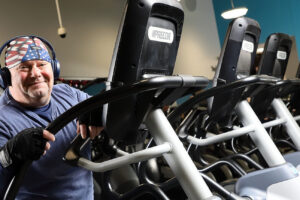 Dee Nemeth had rarely been sick in his life, so it was unusual when the 75-year-old Freehold resident began experiencing bloating last fall. After seeking care at a health clinic, he was sent to CentraState’s Emergency Department for a potential gall bladder issue. There, he was diagnosed with a more complex problem: He had several large abdominal aortic aneurysms.
Dee Nemeth had rarely been sick in his life, so it was unusual when the 75-year-old Freehold resident began experiencing bloating last fall. After seeking care at a health clinic, he was sent to CentraState’s Emergency Department for a potential gall bladder issue. There, he was diagnosed with a more complex problem: He had several large abdominal aortic aneurysms.
An abdominal aortic aneurysm is a weak, bulging area in the aorta, the body’s largest artery that carries blood from the heart to the rest of the body. Aneurysms can rupture, which is fatal in about 80 percent of patients who have this complication.
Minimally Invasive Repair Had Limitations
Many abdominal aortic aneurysms can be corrected with minimally invasive endovascular repair (EVAR), which involves inserting a stent graft (a synthetic tube-like device) into the femoral artery in the groin and guiding it to the damaged area of the blood vessel in the abdomen. The stent graft relines the blood vessel so that it can absorb the force of each heartbeat instead of the weakened artery. But in some patients, the aneurysm may be too close to other important arteries to make this procedure possible.
Dee was one of these patients. His large aneurysms were in risky locations—one was next to his renal arteries that branch out to the kidneys, and another was close to the iliac arteries that branch down into the pelvis.
“Major abdominal surgery was once required for patients with these complex abdominal aortic aneurysms, because blood flow would be cut off to important organs if EVAR were performed,” says Tushar Tripathi, MD, a board-certified vascular surgeon on staff at CentraState. “If the renal arteries lost blood flow during the procedure, the patient would need dialysis for the rest of his life. Likewise, cutting off blood flow to the pelvic area would result in impotence. Fortunately, we now have newer minimally invasive options.”
Introducing New Custom-Made Options
Dr. Tripathi is the only surgeon in Monmouth and Ocean counties who is performing a new minimally invasive procedure called fenestrated endovascular aortic repair (FEVAR) for complex abdominal aortic aneurysms located near the renal arteries. He is also one of only a handful of surgeons in the region performing the iliac branch endograft repair for abdominal aortic aneurysms near the iliac arteries. Both procedures require extensive experience along with special training by the stent graft manufacturers.
FEVAR uses a fenestrated endograft, which means it has holes that Dr. Tripathi precisely aligns with the renal arteries that branch off the aorta. He can then connect smaller stent grafts to the aortic branches, allowing continuous blood flow to the kidneys. The fenestrated stent graft is custom made to the precise size of the individual patient’s aorta using CT scanning with 3-D modeling prior to the aneurysm repair. Similarly, the pants-shaped iliac branch endograft is custom made, enabling it to fit the iliac branch arteries and preserve blood flow to the pelvic area.
Dee was happy to have these new minimally invasive options, or he may have chosen to forego surgery entirely, despite the risk of rupture. When he was being measured for his custom stent grafts, Dr. Tripathi walked him through the entire process and answered his questions.
“That initial measurement gave me 100 percent confidence in Dr. Tripathi,” Dee says. “He had a positive attitude right from the beginning. Plus, my wife, Barbara, was very happy that I would no longer be walking around at risk.”
Home the Next Day
FEVAR and the iliac branch repair are performed in the Cardiac and Endovascular Lab at CentraState, and they offer a number of significant benefits over traditional open surgery, including a shorter hospital stay, fewer complications and risks, and a faster recovery time. In fact, Dee was able to return home the day after his surgery.
“I was shocked at how easy the recovery was, especially for something that complex,” Dee adds. “I had two band-aids on a small incision, and that was it. As Barbara says, it’s great to know we have this level of expertise right here in our hometown.”
Patients who experience a throbbing feeling in the stomach or deep pain in the lower back or side of the abdomen, or those who have a family history of aneurysm, should consult with their physician about their risk.
For more information about fenestrated endovascular aortic aneurysm repair (FEVAR), iliac branch repair, or other endovascular interventions at CentraState’s Cardiac and Endovascular Lab, call 866-CENTRA7 (866-236-8727).





